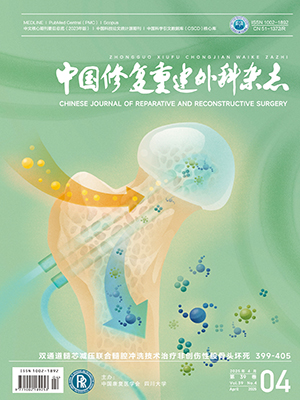| 1. |
Knezevic NN, Candido KD, Vlaeyen JWS, et al. Low back pain. Lancet, 2021, 398(10294): 78-92.
|
| 2. |
Katz JN, Zimmerman ZE, Mass H, et al. Diagnosis and management of lumbar spinal stenosis: A review. JAMA, 2022, 327(17): 1688-1699.
|
| 3. |
Zhao Y, Bo X, Wang C, et al. Guided punctures with ultrasound volume navigation in percutaneous transforaminal endoscopic discectomy: A technical note. World Neurosurg, 2018, 119: 77-84.
|
| 4. |
Coric D, Rossi VJ, Peloza J, et al. Percutaneous, navigated minimally invasive posterior cervical pedicle screw fixation. Int J Spine Surg, 2020, 14(s3): S14-S21.
|
| 5. |
Liu H, Wu J, Tang Y, et al. Percutaneous placement of lumbar pedicle screws via intraoperative CT image-based augmented reality-guided technology. J Neurosurg Spine, 2019, 20: 1-6.
|
| 6. |
McCloskey K, Turlip R, Ahmad HS, et al. Virtual and augmented reality in spine surgery: A systematic review. World Neurosurg, 2023, 173: 96-107.
|
| 7. |
Zhang M, Li J, Fang T, et al. Application of 3-dimensional printing guide template and pointed lotus-style regulator in percutaneous pedicle screw fixation for thoracolumbar fractures. Sci Rep, 2022, 12(1): 2930.
|
| 8. |
曾柏方, 吴超, 李涛, 等. 3D打印皮外导板辅助微创椎弓根螺钉植入治疗多节段胸腰椎骨折. 中国修复重建外科杂志, 2021, 35(6): 742-749.
|
| 9. |
Lin S, Wang F, Hu J, et al. Comparison of the accuracy and safety of TiRobot-assisted and fluoroscopy-assisted percutaneous pedicle screw placement for the treatment of thoracolumbar fractures. Orthop Surg, 2022, 14(11): 2955-2963.
|
| 10. |
Yang JS, He B, Tian F, et al. Accuracy of robot-assisted percutaneous pedicle screw placement for treatment of lumbar spondylolisthesis: A comparative cohort study. Med Sci Monit, 2019, 25: 2479-2487.
|
| 11. |
Panchmatia JR, Vaccaro AR, Wang W, et al. Lumbar percutaneous pedicle screw breach rates: A comparison of robotic navigation platform versus conventional techniques. Clin Spine Surg, 2020, 33(4): E162-E167.
|
| 12. |
Chang CC, Chang HK, Wu JC, et al. Comparison of radiation exposure between O-arm navigated and C-arm guided screw placement in minimally invasive transforaminal lumbar interbody fusion. World Neurosurg, 2020, 139: e489-e495.
|
| 13. |
Kim HC, Jeong YH, Oh SH, et al. Single-position oblique lumbar interbody fusion and percutaneous pedicle screw fixation under O-arm navigation: A retrospective comparative study. J Clin Med, 2022, 12(1): 312.
|
| 14. |
Li C, Li H, Su J, et al. Comparison of the accuracy of pedicle screw placement using a fluoroscopy-assisted free-hand technique with Robotic-assisted navigation using an O-arm or 3D C-arm in scoliosis surgery. Global Spine J, 2022.
|
| 15. |
Feng W, Wang W, Chen S, et al. O-arm navigation versus C-arm guidance for pedicle screw placement in spine surgery: a systematic review and meta-analysis. Int Orthop, 2020, 44(5): 919-926.
|
| 16. |
Ouchida J, Kanemura T, Satake K, et al. Simultaneous single-position lateral interbody fusion and percutaneous pedicle screw fixation using O-arm-based navigation reduces the occupancy time of the operating room. Eur Spine J, 2020, 29(6): 1277-1286.
|
| 17. |
Liu YB, Wang Y, Chen ZQ, et al. Volume navigation with fusion of real-time ultrasound and CT images to guide posterolateral transforaminal puncture in percutaneous endoscopic lumbar discectomy. Pain Physician, 2018, 21(3): E265-E278.
|
| 18. |
Shapey J, Dowrick T, Delaunay R, et al. Integrated multi-modality image-guided navigation for neurosurgery: open-source software platform using state-of-the-art clinical hardware. Int J Comput Assist Radiol Surg, 2021, 16(8): 1347-1356.
|
| 19. |
Moritz AK, Winter K, Köhler C, et al. Evaluation of the accuracy of volume navigation of sonography and computed tomography using a phantom. Tierarztl Prax Ausg K Kleintiere Heimtiere, 2019, 47(5): 322-333.
|
| 20. |
Miyata A, Arita J, Kawaguchi Y, et al. Simulation and navigation liver surgery: an update after 2, 000 virtual hepatectomies. Glob Health Med, 2020, 2(5): 298-305.
|
| 21. |
Zielinski AH, Bredahl KK, Ghulam QM, et al. Full-volume assessment of abdominal aortic aneurysm by improved-field-of-view 3-D ultrasound performs comparably to computed tomographic angiography. Ultrasound Med Biol, 2022, 48(2): 283-292.
|
| 22. |
王冰, 刘涛. 超声容积导航与X线透视引导下椎间孔镜技术治疗腰椎间盘突出症的临床对比. 颈腰痛杂志, 2019, 40(3): 370-372.
|
| 23. |
Zhao Y, Yan N, Yu S, et al. Reduced radiation exposure and puncture time of percutaneous transpedicular puncture with real-time ultrasound volume navigation. World Neurosurg, 2018, 119: e997-e1005.
|
| 24. |
Chan A, Parent E, Mahood J, et al. 3D ultrasound navigation system for screw insertion in posterior spine surgery: a phantom study. Int J Comput Assist Radiol Surg, 2022, 17(2): 271-281.
|
| 25. |
Gueziri HE, Georgiopoulos M, Santaguida C, et al. Ultrasound-based navigated pedicle screw insertion without intraoperative radiation: feasibility study on porcine cadavers. Spine J, 2022, 22(8): 1408-1417.
|
| 26. |
郭楚, 刘达, 吴文波, 等. 基于电磁定位的超声图像与CT图像的融合方法. 中国生物医学工程学报, 2018, 37(5): 529-536.
|
| 27. |
杜心如, 叶启彬, 赵玲秀, 等. 腰椎人字嵴顶点椎弓根螺钉进钉方法的解剖学研究. 中国临床解剖学杂志, 2002, 20(2): 86-88.
|
| 28. |
王天艺, 袁硕, 范宁, 等. 超声与CT图像融合技术及其在脊柱外科中的应用进展. 中国脊柱脊髓杂志, 2021, 31(1): 86-90.
|
| 29. |
De Silva T, Uneri A, Zhang X, et al. Real-time, image-based slice-to-volume registration for ultrasound-guided spinal intervention. Phys Med Biol, 2018, 63(21): 215016.
|




